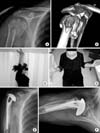Abstract
Purpose
To evaluate the outcome of hemiarthroplasty with bone block graft and low profile prosthesis (Aequalis® fracture prosthesis) for the comminuted proximal humerus fractures.
Materials and Methods
Sixteen low profile prostheses were used since July 2004, and 11 patients were followed-up for average 19.9 (12~30) months. Their mean age was 67.3 (52~78) years. Pain and satisfaction visual analog scale (VAS), range of motion, and modified UCLA score for hemiarthroplasty were evaluated at every visit. Radiography was also checked for stem position, loosening, and tuberosity union.
Results
Mean pain VAS was 2.7 (0~5), and mean satisfaction VAS was 8.4 (5~10). Mean active forward flexion was 137° (90~170), external rotation at side was 45.5° (25~70), and internal rotation at back was T10 (T7~L1). Modified UCLA score was 19 (12~30) at final visit. All stems were stable, and there were no loosening at the final follow-up. All tuberosities were united except two tuberosity absorptions.
Conclusion
The outcome of hemiarthroplasty with bone block graft and low profile prosthesis was comparable to other implants for comminuted proximal humerus fractures. This system had unique advantages for tuberosity union. Further study with more patients and longer follow-up are necessary to clarify the effectiveness of this prosthesis.
Figures and Tables
 | Fig. 1(A) Initial radiography and (B) 3D-CT scan of right shoulder of 60 year old female shows the four part fracture of the proximal humerus. (C, D) Photographs depict the range of motion of patient at 1 year after the hemiarthroplasty with bone block graft and low profile prosthesis. Her forward elevation was 170 degrees, external rotation at side was 70 degrees, and internal rotation at back was T7 level. Her pain VAS was 4, and satisfaction VAS was 10. (E) Anteroposterior and (F) axial view of radiographies at 2 years 6 months after surgery illustrate the stable prosthesis without loosening. Prosthetic head position from the greater tuberosity and glenoid looked appropriate. |
References
1. Agorastides I, Sinopidis C, Meligy M, Yin Q, Brownson P, Frostick SP. Early versus late mobilization after hemiarthroplasty for proximal humeral fractures. J Shoulder Elbow Surg. 2007; 16:Suppl 3. S33–S38.

2. Boileau P, Caligaris-Cordero B, Payeur F, Tinsi L, Argenson C. Prognostic factors during rehabilitation after shoulder prostheses for fracture. Rev Chir Orthop Reparatrice Appar Mot. 1999; 85:106–116.
3. Boileau P, Krishnan SG, Tinsi L, Walch G, Coste JS, Mole D. Tuberosity malposition and migration: reasons for poor outcomes after hemiarthroplasty for displaced fractures of the proximal humerus. J Shoulder Elbow Surg. 2002; 11:401–412.

4. Demirhan M, Kilicoglu O, Altinel L, Eralp L, Akalin Y. Prognostic factors in prosthetic replacement for acute proximal humerus fractures. J Orthop Trauma. 2003; 17:181–188.

5. Hoffmeyer P. The operative management of displaced fractures of the proximal humerus. J Bone Joint Surg Br. 2002; 84:469–480.

6. Iannotti JP, Gabriel JP, Schneck SL, Evans BG, Misra S. The normal glenohumeral relationships. An anatomical study of one hundred and forty shoulders. J Bone Joint Surg Am. 1992; 74:491–500.

7. Kralinger F, Schwaiger R, Wambacher M, et al. Outcome after primary hemiarthroplasty for fracture of the head of the humerus. A retrospective multicentre study of 167 patients. J Bone Joint Surg Br. 2004; 86:217–219.
8. Mighell MA, Kolm GP, Collinge CA, Frankle MA. Outcomes of hemiarthroplasty for fractures of the proximal humerus. J Shoulder Elbow Surg. 2003; 12:569–577.

9. Misra A, Kapur R, Maffulli N. Complex proximal humeral fractures in adults - a systematic review of management. Injury. 2001; 32:363–372.

10. Naranja RJ Jr, Iannotti JP. Displaced three- and four-part proximal humerus fractures: evaluation and management. J Am Acad Orthop Surg. 2000; 8:373–382.

11. Neer CS 2nd. Displaced proximal humeral fractures. II. Treatment of three-part and four-part displacement. J Bone Joint Surg Am. 1970; 52:1090–1103.
12. Park JO, Park JY, Lee ST, Park HK. Open intramedullary nail with tension band sutures and lock sutures on proximal humeral three-part fracture. J Korean Fract Soc. 2007; 20:45–52.

13. Robinson CM, Page RS, Hill RM, Sanders DL, Court-Brown CM, Wakefield AE. Primary hemiarthroplasty for treatment of proximal humeral fractures. J Bone Joint Surg Am. 2003; 85:1215–1223.

14. Suh KT, Roh HL, Youn MS, Lee JS. The treatment of the unstable proximal humerus fracture using bifurcate angled blade plate with tension band wiring. J Korean Fract Soc. 2006; 19:424–430.

15. Young TB, Wallace WA. Conservative treatment of fractures and fracture-dislocations of the upper end of the humerus. J Bone Joint Surg Br. 1985; 67:373–377.





 PDF
PDF ePub
ePub Citation
Citation Print
Print





 XML Download
XML Download